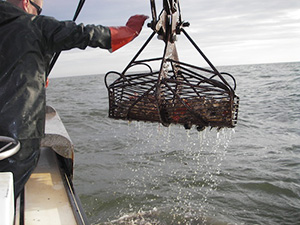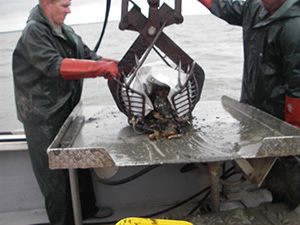2.2 Mechanical and Hydraulic Patent Tongs as Sampling Tools
 2.3 Link to Survey Design: Coverage of the Spatial Footprint of Interest
2.3 Link to Survey Design: Coverage of the Spatial Footprint of Interest
Mechanical patent tongs, like classic grabs or cores, sample from a known area, so the swept area at less than 100% retention efficiency concerns associated with dredges are moderated but not eliminated. The challenge is to assess the efficiency of sampling in the area enclosed by the tong opening as it sits on the bottom. This is influenced by tong weight, length of tong teeth, bottom type and deployment protocol (that collectively determine how far the teeth initially penetrates the bottom) and by retrieval protocol. A typical mechanical patent tong is designed to close as it is recovered – both actions occur simultaneously. Herein lies its weakness as a sampling tool in that a well operated mechanical patent tong in fishing mode both sorts and retrieves in one action. It is selective by design, especially so when bottom penetration is limited. This is problematic where natural reefs retain their base structural integrity, such as in the James River where exploitation has been limited to hand tongs with their limited bottom penetration ability. Thus mechanical patent tongs sample the surface layer with greater consistency than underlying layers; the latter are poorly sampled if at all. As will be addressed in later discussion related to brown (oxic region above the sediment-water interface) versus black (buried, anoxic) shell data, the inability to simultaneously sample the underlying shell habitat limits the use of mechanical patent tongs in comprehensive studies. Finally, most mechanical tongs have limited covers and are thus susceptible to spillage of material during retrieval – mostly small material that is of limited interest in fisheries with minimum size limits. This material is, however, often critical in stock assessment.
 Hydraulic patent tongs separate the actions of closing from retrieval. Thus each can be optimized in design rather than compromised. The hydraulic tong is heavier than a mechanical tong of comparable opening allowing both deeper initial penetration of the bottom and ensuring that tong continues to “dig” during the closing action. The same arguments apply in the design of certain grabs that also separate closing from retrieval. The result is a deeper sampling into the aforementioned vertically stratified structure of the reef. Once closed the hydraulic patent tong is then retrieved. The tong used in Virginia studies has the optional cover to retain surface material and the integrity of the surface in the retained sample. Total volume retained in a single sample can regularly exceed 50L with an intact surface layer. Penetration through the live animal – oxic shell layer to the underlying black anoxic shell layer illustrates complete sampling of the layered reef crust.
Hydraulic patent tongs separate the actions of closing from retrieval. Thus each can be optimized in design rather than compromised. The hydraulic tong is heavier than a mechanical tong of comparable opening allowing both deeper initial penetration of the bottom and ensuring that tong continues to “dig” during the closing action. The same arguments apply in the design of certain grabs that also separate closing from retrieval. The result is a deeper sampling into the aforementioned vertically stratified structure of the reef. Once closed the hydraulic patent tong is then retrieved. The tong used in Virginia studies has the optional cover to retain surface material and the integrity of the surface in the retained sample. Total volume retained in a single sample can regularly exceed 50L with an intact surface layer. Penetration through the live animal – oxic shell layer to the underlying black anoxic shell layer illustrates complete sampling of the layered reef crust.
Both mechanical and hydraulic patent tongs sample a small footprint, typically on the order of one square meter (the design of the hydraulic tong used by VMRC-VIMS). Thus spatial variation in the reef environment is a critical problem in sampling using tongs. This issue is addressed in the Shell Habitat Section.
Link to Survey Design: Coverage of the Spatial Footprint of Interest

